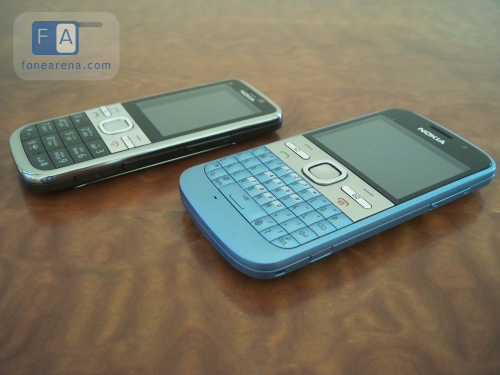The Nokia C5 and E5 are part of the relatively new Nokia line-up of devices, after the naming convention change. Both are middle class in their series, with the C5 being more a classic phone, and the E5 more an Enterprise phone, with a full QWERTY keyboard. Despite belonging to two different categories, both bare a striking resemblance, design-wise, hardware-wise, and software-wise.
On a hardware basis, the C5 has a 2.2″ transmissive screen at a 240×320 resolution with 24bit colors. It has a total volume of 56.2cc and weighs about 89g, with a 600 MHz processor and a 1050 mAh battery that can be charged both by the regular charger and microUSB. The connectivity options are limited to Bluetooth, EDGE, 3G and HSUPA, with no Wi-Fi on board. Storage-wise, it has 50MB of internal memory, 128MB of RAM, and comes with a 2GB hot-swappable microSD. As for the camera, it’s a 3.2MP EDoF camera.
The E5, on the other hand, has a larger 2.4″ transmissive screen at a 320×240 resolution with only 18bit colors. It weighs much more at 126g and has a larger volume of 75cc. It features quick access to a torch and a bluetooth toggle, and has a dedicated Messaging button. It also comes with a 600MHz processor and a much optimized 1200 mAh battery that can also be charged by a regular 3-pin or microUSB. Its connectivity options are the same as the C5, but it adds support for WiFi. As for storage, it has a whopping 250MB of internal memory, 256MB of RAM which should both guarantee a problem-free usage, and a 2GB non hot-swappable microSD. It has a 5MP EDoF camera.
Software-wise, both handsets are S60 3rd Edition FP2, which is Nokia’s most perfected OS to date, with support for OTA updates and Access Point prioritization thanks to Destinations, as well as a lot of nice options for the homescreen including the Contacts Bar design that lets you access communications with your favorite contacts in an instant. The E5 also supports the Active homescreen, known from the E71/E72 that lets you Switch Modes from Business to Personal, as well as have an integrated view of your missed calls and unread SMS. Predictive text is present on both handsets, with the C5 being able to pick two languages simultaneously for text entry on the T9, whereas the E5 only lets you pick one.
They both come with a slew of Ovi/Nokia apps installed, like Ovi Contacts, Ovi Store, Ovi Maps with free navigation, Ovi Music, Ovi Sync, Nokia Messaging, Chat, Share Online, Music Search, Real player. They also both come with office applications namely Dictionary, Zip, Adobe PDF, but the QuickOffice version of the C5 is read-only (you need to pay to upgrade to a read-and-write version), whereas the E5 one is a full read-and-write version. They both have a dedicated Facebook application that integrates with the Contacts phonebook as we demo’ed earlier. The C5 adds one game, Bounce Tales. The E5 adds a lot more pre-installed apps, like Ovi Files, Shazam, Podcasting, Microsoft Communicator, Intranet, Font Magnifer, Vlingo, Bloomberg, AP Mobile.
Now that we’ve outlined the differences, let’s get into a more detailed picture hardware tour of both handsets. First up is the front design of the two handsets. Notice the similar middle silver band, d-pad and functions keys, the raised and rounded keyboard/keypad keys, and the black rim around the screen.
Seen from the sides, you can clearly spot the similarities of the curves between the C5 & E5, which gives them a significantly identical feel in the hand.
The left and bottom sides of both devices are void of anything, apart from the strap hook on the C5’s left.
On the right side, the C5 has volume keys and the microSDHC door. The E5 has volume keys and the strap hook.
The top of both handsets has the microUSB port, the 3-pin charging hole, and the 3.5mm headset plug.
On the back, both handsets have the same brushed aluminum battery cover, with a rounded edge design, and their respective cameras. Both are recessed a bit to avoid scratches, with the E5 featuring a more significant recess and a design over the camera.
Under the battery cover are the 1020 mAh and 1200 mAh batteries for the C5 and E5 respectively. The E5’s microSDHC tray is located below the battery.
And finally here are two photos of the E5 and C5 turned on, to show the identical Contacts Bar homescreen and Facebook application.
Eventually, if you’re torn between both handsets, it all comes down to a few differences. QWERTY and T9 is the most obvious one, then you’ll see that the E5 is significantly larger and heavier but that allows it to pack more RAM, more internal memory, WiFi, more battery power, a better camera, and a few more pre-installed apps, while compromising on the hot-swappable memory card and the screen color definitions.
Are you a fan of the design language on this new lineup from Nokia? And when it comes to QWERTY or T9, which one do you prefer, and are the C5/E5 something you’re interested in?













